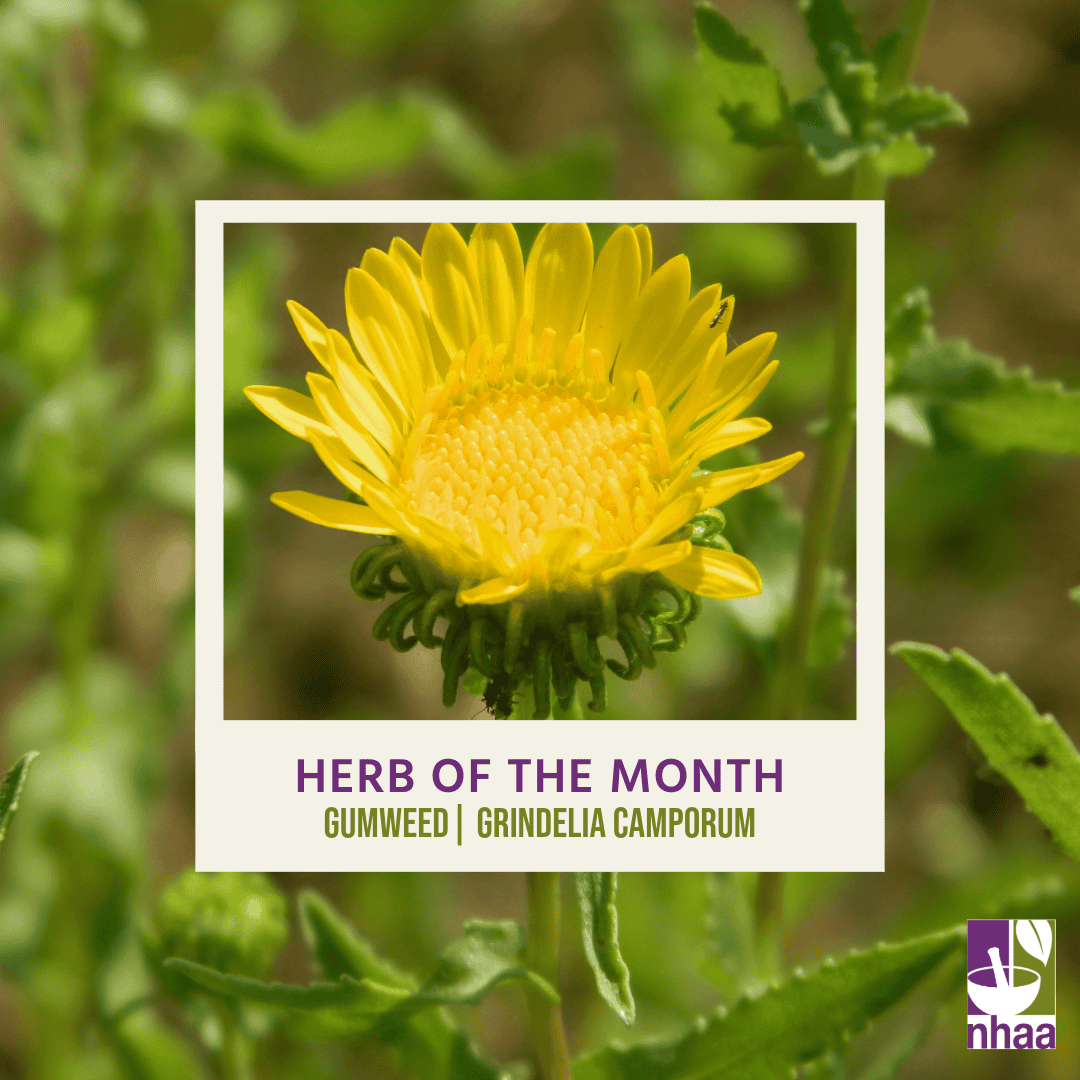
🌿 This month’s Herb of the Month is Gumweed or Grindelia camporum
Family: Asteraceae
🌿 Botanical name and description
Commonly known as Gumweed, G. camporum is part of a large genus that grow natively across a wide expanse of the US in a wide array of conditions. Some sources group G. camporum in with over 25 other taxa in the G. hirsutula, many of which have similar medicinal properties (however this monograph focuses only on G. camporum, which is native to California) (1).
G. camporum grows to a height of anywhere between 2-6 feet, with a dramatic die back to a basal rosette in the Winter months and an equally dramatic seed bolt from the perennial rootstock. (2) It is notoriously complex to identify due to its unusual constellation of botanical features, including branched, gangly stems with what looks like a white varnish on the surface, abundance of ovate to lanceolate leaves and clasping bases. It’s immature flower heads ooze with a sticky white latex to then open into daisy-like flowerheads – ray-like with spectacular, yellow petals. A whorled cup of green bracts curls back from these flowers with the seeds being distinctly flattened and the fruits having a featherlike quality. It is often used in wildflower and pollinator gardens.
🌿 History and traditional use
G. camporum has a well-established traditional use for coughs specifically associated with the common cold. (3) and the majority of its other traditional indications are respiratory conditions, including bronchitis and asthma. Some Native American healing traditions have also used the herb for treating dermatological conditions, both internally and as a water-based wash for wounds, burns, boils and sores and for treating poison ivy and poison oak. (4).
🌿 Actions and usage today
The key indication for G. camporum is a productive cough and/or upper respiratory tract catarrh, including that seen in bronchitis. It is also commonly prescribed where there is inflammation and swelling of the ear, nose and throat and in inflammatory and reactive skin conditions like poison ivy, poison oak and contact dermatitis. (5) It is important to note that these indications are derived from traditional usage, with very limited clinical research and evidence having been completed (as below).
🌿 Science and clinical trials
The main therapeutic active constituents in G. camporum appear to be borneol, several grindelic acids (around 30% volume) and several diterpenic acids, all of which appear in the sticky latex resin of the plant. (5) The resin also contains diterpene derivatives, their methyl esters and stictanonoic acid. Several flavonoids (apigenin 4′-methyl ether, quercetin and its 3,3′-dimethyl ether, and kaempferol 3,7-dimethyl ether) and significant plant sterols are also present. (6, 7, 8).
The essential oil from the flowers and leaves include limonene, a-pinene, and germacrene-D. ) Other volatile components from the oil include b-farnesene, a- humulene, bisabolene, myrcene, b-pinene, and bornyl acetate. (9).
Extracts of the whole herb have demonstrated anti-inflammatory and expectorant qualities in animal studies and antibacterial, antifungal and anti-inflammatory properties in vitro. While no clinical data currently supports these uses, several studies and authoritative herbalists support the use of other Grindelia species as a topical anti-inflammatory, particularly when prepared as an aqueous decoction. (10)
🌿 Science and clinical trials
- Prescribe with the usual caution where a patient presents with an Asteracea sensitivity
- Oral intake may cause diarrhoea and/or stomach upset in sensitive individuals
- There is a lack of evidence for the safety of this herb as a topical treatment and in pregnancy and breastfeeding
- Potential interactions with other herbal medicines, foods and/or medications is currently unknown
- There is no established dosage window for G. camporum however no toxic effects have been observed in animal studies. Conservative prescribing of this herb is encouraged in initial treatment stages
🌿 References
- Strother JL and Wetter MA 2006, Treatment of Grindelia, Flora of North America 20: 424-425
- Hoffman JJ and McLaughlin SP 1986, Grindelia camporum: potential cash crop for the arid Southwest, Economic Botany 40: 169-162
- European Medicines Agency 2012, Community herbal monograph on Grindelia robusta Nutt., Grindelia squarrosa (Pursh) Dunal, Grindelia humulis Hook. Et Arn., Grindelia camporum Greene, herba. Available online at: https:// www.ema.europa.eu/en/documents/herbal-monograph/final-community-herbal-monograph-grindelia-robusta-nutt-grindelia-squarrosa-pursh-dunal-grindelia-humilis-hook-et-arn-grindelia-camporum-greene-herba_en.pdf Viewed 3rd July 2024
- Forster S and Hobbs C 2002, A field guide to western medicinal plants and herbs, Houghton Mifflin Company, New York
- ESCOP Monographs 2016, Grindileae herba. Available online at: https:// www.escop.com/downloads/grindelia/
- Hoffman JJ Kingsolver BE, McLaughlin S 1984., Production of resins by arid-adapted Astereae. Rec. Adv. Phytochem., 18:251-71
- Timmerman BN, Hoffmann JJ, Jolad SD, 1985 Grindelane diterpenoids from Grindelia squarrosa and G. camporum. Phytochem., 24:1031-4
- Bohlmann F, Ahmed M, Borthakur N, 1982. Diterpenes related to grindelic acid and further constituents from Grindelia species. Phytochem., 21:167-72
- Schafer M, Schimmer O, Schultze W 1993. Relative amounts of essential oil components in the flowers, leaves, and stems of four Grindelia species. Planta Med., 59(Suppl.):A634
- Hoffmann D 1996. The Complete Illustrated Holistic Herbal, Element Books, Boston, MA